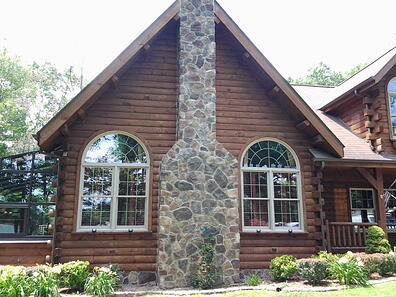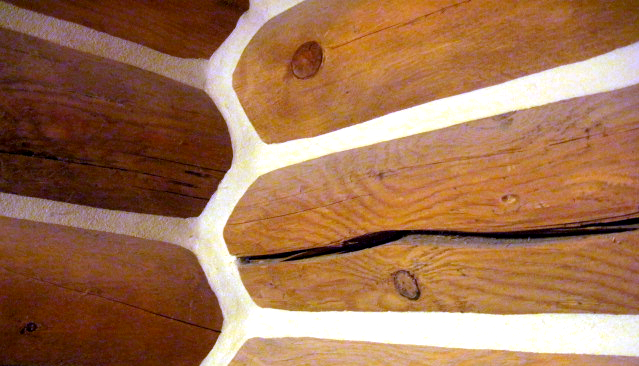Part 3 Of Log Home Restoration | ImageWorks Painting
Jeremy Holderness In part 2 of The Birds, The Bees & The 1-2-3's Of Log Home Restoration we discussed the proper way to prepare the surface and repair any damage to your logs.
In part 2 of The Birds, The Bees & The 1-2-3's Of Log Home Restoration we discussed the proper way to prepare the surface and repair any damage to your logs.
In the final part of this 3-part series we will address the remaining areas of preparing the home for the finish coats, then we will review applying the stain/finish.
Evicting The Squatters
We discussed the common problem of wood boring insects during the inspection phase. If you've discovered these insects have made a home in your home then you must take steps to get rid of them. Many folks resort to conventional methods for trying to kill off the invaders, but if you use the wrong type of pesticide, such as aerosol liquid sprays, you will probably have little to no effect on the population -- or most likely just make them angry.
In my experience, the best way of getting rid of these insects is by using an insecticide dust such as Tempo 1% Dust. For wood-boring bees apply the dust directly into the holes they've bored into the wood. Leave the holes open for at least 24 hours so that any returning bees will also be killed, then seal up the holes with a high-quality caulking. For ants apply the dust to all cracks, crevices, and tunnels in and around the damaged wood areas.
If you suspect that you may have a termite infestation the best course of action would be to call in a professional exterminator to have an inspection done and to discuss your options for remedying the situation.
Although these are effective methods for treating existing pest issues, the best solution is to be proactive about pests. Make sure that your exterior wood surfaces stay well-coated with a stain/sealer as this will usually deter wood boring bees from setting up residence in your home in the first place since they are generally attracted to bare wood. In many cases you can keep from attracting ants and termites by keeping any wet or rotted wood away from your home, and fixing any damaged wood on your home as soon as you notice it. It also may be a good idea to have a preventative general treatment performed where the perimeter walls are sprayed on the exterior of the structure once in the Spring and once in the Fall -- usually at a cost of about $100 or so per treatment, depending on the area where you live.
Weatherproofing The Structure
Seal checks in the logs with a sealant made specifically for log cracks such as Check-Mate. For large checks try installing a foam backer-rod before you apply the sealant. It will help fill the gap to minimize the amount of sealant needed for the job, and give the sealant something to grab onto.
 Chinking is the material that is used to fill-in the gaps between the logs to keep out air, moisture, and insects from getting into the home. Most of the log homes that were constructed in the modern era use logs that are flat on the bottoms and tops and utilize a tongue & groove type of design along with foam gaskets that eliminate the need for chinking -- although some people will still apply chinking for aesthetics.
Chinking is the material that is used to fill-in the gaps between the logs to keep out air, moisture, and insects from getting into the home. Most of the log homes that were constructed in the modern era use logs that are flat on the bottoms and tops and utilize a tongue & groove type of design along with foam gaskets that eliminate the need for chinking -- although some people will still apply chinking for aesthetics.
However, there are still many log homes in use today that require chinking to keep them as a functional structure. Traditionally, natural materials were used as chinking -- from dried mosses to sand/mortar mixtures -- but in today's more modern log structures it is very common to see synthetic chinking materials used. The advantages to these newer building materials are that they remain flexible with the changes in temperature and require less maintenance and repair over time.
If your home has older or inadequate chinking it will need to be repaired or replaced if you want to avoid problems in the future. Depending on the type of chinking you're using and the type of stain you will be applying, it may be necessary for you to do your chinking repair work prior to staining. Make sure you closely follow the manufacturer's recommendations on the proper order of the steps before proceeding.
4.) Apply The Stain & Finish
Now that you've done all of the prep work, it's time to make your home look beautiful. As we discussed earlier in the article, it's very important that you select a stain/finish system that is made specifically for log homes to allow them to properly breathe. We recommend and use Perma-Chink's Lifeline waterborne products as they will allow the pigment (color) to wear away over time, along with the finish -- preventing the build-up of pigment and darkening of the color of the wood as you apply subsequent maintenance coats over the years.
In most cases, 1-2 coats of stain followed by 1-2 coats of clear finish will be required to get the job done. Application can be done with a brush or airless sprayer and back-brush method to work the product into the wood. As with any other premium exterior stain line, you should expect to get at least 3-5 years of life out of your finish before a maintenance coat will need to be applied. Of course, you will need to give your home a good cleaning once every year or two to keep it looking its best.
There's no doubt that log home restoration and maintenance is a big job, but not so big that an ambitious DIY'er couldn't tackle much of it theirself. However, if the whole process seems a bit too intimidating or if you start it your self and get stuck in the middle of the job we'd love to help. As one of the only log home restoration contractors serving the Western Pennsylvania area we're more than happy to assist you in completing your project.
To request a free consultation and quote for your log home restoration project call us at (724) 898-2446 or click on the button below!
photo by: Jaix Chaix








